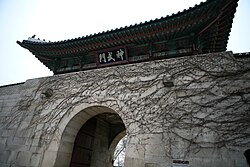Fortress Wall of Seoul

The Fortress Wall of Seoul (Hanja: 서울 漢陽都城; Hangul: 서울 한양도성;), or literally the Seoul City Wall is a series of walls made of stone, wood and other materials, built to protect the city of Seoul against invaders. The wall was first built in 1396 to defend and show the boundaries of the city, surrounding Hanyang (Hanja: 漢陽; Hangul: 한양 the old name for Seoul) in the Joseon Dynasty. At that time, it was called Hansung (Hanja: 漢城; Hangul: 한성). The wall stretches 18.6 km along the ridge of Seoul's four inner mountains, Bugaksan, Inwangsan, Naksan and Namsan. At present, a 12-km section of the wall is designated as Historic Site No. 10 (1963) and is protected accordingly, along with the gates, water gates, and signal fire mounds. The northern, eastern, and southern sections of Mt.Nam (Namsan section) walls have undergone extensive restoration work, having sustained damage or been entirely destroyed during Japanese imperial rule (1910–1945).
Excerpt from the Wikipedia article Fortress Wall of Seoul (License: CC BY-SA 3.0, Authors, Images).Fortress Wall of Seoul
Samcheong Tunnel), Seoul
Geographical coordinates (GPS) Address Nearby Places Show on map
Geographical coordinates (GPS)
| Latitude | Longitude |
|---|---|
| N 37.595277777778 ° | E 126.98055555556 ° |
Address
숙정문
Samcheong Tunnel)
03050 Seoul
South Korea
Open on Google Maps










